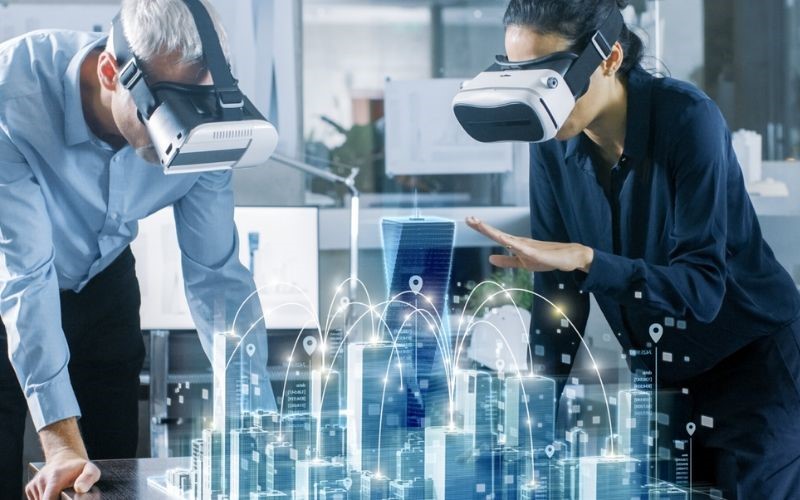The term “metaverse” refers to an immersive, social, and hyper realistic virtual setting where individuals will have the opportunity to interact while using 3D customized avatars.
In his science fiction book “Snow Crash,” which was published in 1992, author Neal Stephenson introduced the term.
The book relates the tale of “Hiro Protagonist,” a figure who, while a pizza delivery kid in real life, is a samurai in the fictional metaverse.
The concept is for the metaverse to have its own virtual economy and for individuals to be able to work, own houses, purchase items for their wardrobes, attend events, have meetings, and genuinely live online.
As companies compete to create platforms that will attract users to their own regions of the metaverse, virtual environments are becoming more common and more sophisticated, for platforms like Spatial.io, Microsoft Mesh and Facebook’s Horizon Worlds, metaverse feels like an extension of work or life, where avatars can meet in bright modern environments or supernatural encounter landscapes.
Meanwhile, mega-platforms like The Sims, Minecraft, Second Life and Roblox have been building expansive and immersive virtual worlds for years, allowing players to build their own structures and explore these ever-expanding landscapes.
People will no longer navigate a single metaverse; rather, they will travel across a number of connected metaverses that can communicate with one another in a huge digital environment. These metaverses will all be supported by the blockchain and on-platform currencies that drive their meta-economies.
For many years, the built environment was mostly shaped by architects, engineers, and builders. Because the physical world is so complex, it needs safeguards like rules, zoning, accreditations, and best – practice. There are rational reasons why not everyone is capable of constructing a skyscraper.
Real architecture differs from a metaverse in certain ways. The characteristics of the location itself make the biggest difference, Additionally, there won’t be any real-world rules or restrictions in the metaverse, such as gravity, construction stability, climate challenges, or physical laws. However, in a virtual environment, every location has a purpose or a storyline. Therefore, architects are free to overcome the constraints at hand and produce remarkable surroundings and genuine works of art.
Last but not least, despite the fact that in modern architecture visualizations are created to show potential customers the atmosphere and features of a space before construction begins, in the metaverse the entire environment is created with the same amount of time and effort that is put into visualization.
It is clear that architects contribute a significant amount to the implementation of creative environment in the metaverse. In order to construct or improve these spaces, architects and designers are required since people need places to interact within in the metaverse.
However, as this new world expands, our perspective of what characterizes an architect may modify. It’s possible that as time goes on, the terms “architect” and “meta-architect” will become separate due to the
change in architecture’s goals. While traditional architecture is essential for enabling our daily activities and providing shelter, meta-architects will focus exclusively on form, geometry, and visuals.
Architects designing for the metaverse might need to develop new skills and change their perspective. In the metaverse, architects must perform the 3dmodeling and include expert knowledge from several disciplines, such as user interface, content, character, and even game design. And this will allow a greater number of individuals to access to the realm of architecture. The process of creating this cutting-edge architectural design will include more people.
In addition, this new generation of architects will require guidance in a combination of digital media and 3D technologies. This results in a change that goes beyond the development of architecture, building methods, and materials.
Finally, in the metaverse, the entire environment is developed with the same amount of time and effort that is spent simply on visualization, whereas in present architecture, visualizations are created to communicate the mood and details of the space to the audience before the creation.
Metaverse is regarded as both beneficial and detrimental for architects. For instance, a digital twin of an actual project can be created in the virtual environment of the metaverse in which clients have the authority to live there for a month to see if they enjoy the space before building it.
Design companies in the realm of the virtual world
Zaha Hadid Architects
Zaha Hadid Architects have recently collaborated with PUBG Mobile to create a virtual environment where players worldwide can experience an interactive entertainment experience. It is a realm where up to 100 individuals defeat other players in an aesthetically and technically rich battleground.
ILLUSORR
ILLUSORR is a design-oriented metaverse that merges the physical and virtual worlds to create original environments and experiences. It aims to redefine the once fragmented virtual reality business as an all-in-one platform that provides corporations, creatives, and individuals with a completely immersive metaverse experience.
Decentral and Architects
Decentral and Architects is a blockchain virtual world founded in March 2021. They provide 3d design and architecture for customers to build and develop professional virtual real estate. Users can use the in-game cryptocurrency Mana to buy parcels and plots of land and spend their time in an immersive environment.


